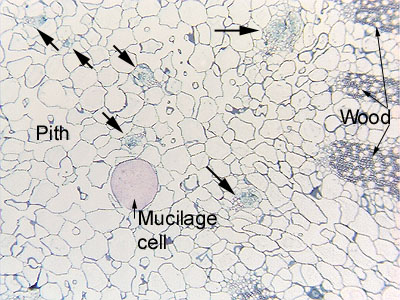 Fig.
11.4-5. Transverse
section of cactus stem (Morawetzia doelziana; no common name). The low
magnification micrograph shows the pith (and a little bit of the surrounding
wood on the right). There
are numerous vascular bundles in the pith (vascular bundles in the pith are
known as medullary bundles), but at this low magnification they are
difficult to see. The high magnification micrograph shows one medullary bundle:
it is collateral, having both xylem and phloem.
Fig.
11.4-5. Transverse
section of cactus stem (Morawetzia doelziana; no common name). The low
magnification micrograph shows the pith (and a little bit of the surrounding
wood on the right). There
are numerous vascular bundles in the pith (vascular bundles in the pith are
known as medullary bundles), but at this low magnification they are
difficult to see. The high magnification micrograph shows one medullary bundle:
it is collateral, having both xylem and phloem.
Most cacti have
both cortical bundles and medullary bundles. And of course they all have the
ordinary bundles that make up the central ring of vascular bundles.
Consequently, their stems have three sets of vascular tissues, and they are all
interconnected: medullary bundles and cortical bundles both attach to the
central ring of bundles, and medullary bundles can run through the parenchyma
between the main bundles and connect directly with cortical bundles. By having
these two extra sets of vascular tissues, it is feasible for the cortex and pith
of cacti to evolve to be much larger than the corresponding tissues in ordinary
non-succulent plants.
For more
information on medullary bundles, see:
Mauseth, J. D. 1993. Medullary bundles
and the evolution of cacti. American Journal of Botany 80: 928-932.